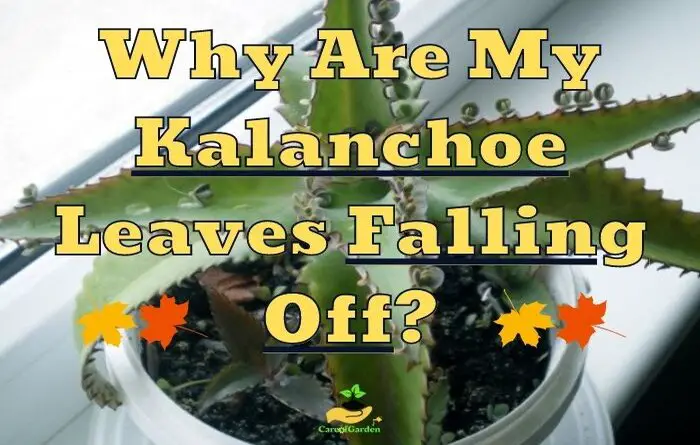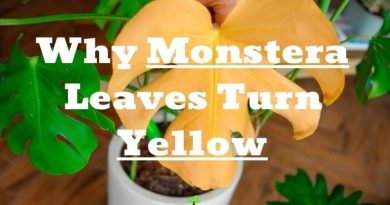Why Are My Kalanchoe Leaves Falling Off? (Easy Answer)
Kalanchoe is a succulent plant that grows in many houses, including mine, because is undemanding in care. However, recently I’ve noticed that the leaves of my kalanchoe plant have been falling off and I can’t help but wonder what’s causing this issue.
If you’ve been asking yourself the question “why are my kalanchoe leaves falling off?”, you’re not alone.
This can happen for various reasons including overwatering, underwatering, environmental factors, wrong soil, and even pests.
| Reasons why the Kalanchoe leaves are falling off |
|---|
| 1. Insufficient sunlight |
| 2. Using the Wrong Soil |
| 3. Improper watering |
| 4. Wrong temperature and Seasonal changes |
| 5. Excessive Fertilizer Use |
| 6. Pests |
| 7. Diseases |
1. Insufficient Sunlight
The first reason that causes kalanchoe leaves to fall or drop is insufficient sunlight. Kalanchoe like all plants, requires the right amount of light to make food through a process called photosynthesis. If there is a lack of sunlight the plant can become stressed and may drop its leaves to conserve resources.
Kalanchoe, like most plants, requires sunlight to grow. These plants need at least 6 hours of indirect sunshine per day. It is critical to remember that some succulents cannot tolerate direct sunshine.
Furthermore, you can locate the kalanchoe plants in a shady location, and they may survive in those conditions better than the other sorts. You must avoid exposing them to direct sunlight, which may cause the plant’s leaves to fall off. If you do not supply appropriate sunshine levels, they will shed leaves.
For some varieties of Kalanchoe, direct sunlight is a negative factor for indoor growth. In this case, the leaves may curl and brown spots appear on them, which indicate that the leaf plate has been sunburned.
Treatment
You can determine how much sunlight your kalanchoe needs as follows:
If the upper leaves turn yellow and fall and the lower leaves remain green this means that the kalanchoe does not have enough sunlight.
As a result, indirect sunshine and partial shade are required for these plants to thrive. It would be best if you supplied plenty of indirect sunlight so that they could avoid the etiolation situation. If cold weather is approaching, bring the plant indoors and place them beside a bright sunny window.
Kalanchoe does not tolerate direct sunlight, so it is necessary to place it away from the window in case of excess lighting or do the opposite if there is not enough light.
Kalanchoe should not be placed close to the window, as it reflects the sun’s rays and can burn the leaves.
2. Using The Wrong Soil
Kalanchoe need a specific type of soil to grow and using the wrong type of soil (soil is too heavy or doesn’t drain well), will likely cause kalanchoe leaves to fall.
If the soil is too heavy or doesn’t drain well, it can cause the roots to become waterlogged and prevent oxygenation.
If the soil doesn’t contain enough nutrients or is too dry, kalanchoe will not have the strength to grow and keep its leaves healthy leading to leaf drop.
Treatment
The right soil mix is also essential for keeping your Kalanchoe healthy and avoiding infections that could harm your plant. When planting your Kalanchoe, use a soil mix that is 50% potting soil as well as 50% cactus potting soil. You can also use a mixture of 60% peat moss and 40% perlite.
These are the ideal combinations since they give excellent drainage and the appropriate moisture level. A clay pot can assist in excess water draining from the soil.
3. Improper Watering
Improper watering techniques are the third most common reason why Kalanchoe leaves fall.
- Overwatering: Kalanchoe is able to some extent to accumulate water in its leaves. That’s why they look fleshy and dense like flowers. And if you water the plant, the leaves will start to fall.
- Insufficient water: Of course, Kalanchoe can be without water for some time (even the appearance of an earthen crust in the pot is allowed), but if the watering is insufficient, the leaves will dry. With prolonged drying, they fall off.
Overwatering
Overwatering will cause the plant leaves to swell. In addition, leaves would become mushy and soft to the touch, eventually falling from the kalanchoe.
Overwatering occurs when the kalanchoe receives more water than it can absorb, leading to a lack of oxygen in the soil. This issue is causing an incapability in kalanchoes to access the required nutrients. As a consequence the stem begins to wither and the leaves fall off.
Overwatering can be caused by several factors, such as watering too frequently, using pots without proper drainage, or using soil that doesn’t drain well.
Treatment
To fix overwatering issues, you need to adjust your watering habits.
Kalanchoe is not a water-demanding plant, one watering per week when it’s hot (among the constraints of our heated interiors in winter), one every 15 days in spring and autumn, and that’s it !!
Make sure that the pot has proper drainage holes to prevent water from pooling. In addition, consider using well-draining soil, such as a cactus or succulent mix, which will help prevent overwatering.
My trick, as for all my other indoor plants: only water when the soil is dry at the foot of the plant, and preferably with rainwater; I never leave water in the cups under the pots, it promotes rot (I water in the sink).
Lack of water
Kalanchoe flowers need a balance of watering and in case of lack of water, they may drop leaves to conserve moisture, causing leaves to turn yellow, and eventually start falling off.
Underwatering can be caused by a variety of factors, such as infrequent watering, using pots that are too small, or growing the plant in soil that doesn’t retain water well.
Kalanchoe should be watered with settled and soft water, otherwise, various diseases and other issues may appear.
Treatment
Water your kalanchoes plants deeply when you notice the soil is dry. Make sure to have a proper pot for the size of the plant allowing excess water to drain away from the roots.
4. Wrong Temperature And Seasonal Changes
Growing your plant at the wrong temperature could cause leaf loss.
Temperature fluctuations can cause kalanchoe leaves to fall or drop because the plant prefers to grow in a specific temperature range. If the temperature gets too hot or too cold for the plant, it can become stressed and drop its leaves.
If the air temperature stays around 86°F (30°C) for a long time, the leaves of the plant begin to turn yellow and fall. First, in Kalanchoe, the oldest lower leaves dry and fall, but if coolness does not come, yellowing of young leaf plates also begins.
Kalanchoe grows best in air-conditioned rooms, where it is easy to regulate the air temperature even in the summer heat. If there is no air conditioner in the room, in the summer the flower is kept on the north-eastern window sills, where it is not hot, and the sun is only in the morning.
Low Temperatures
While Kalanchoe is not as picky as other plants, it does not fare well in cold weather. Kalanchoe thrives in temperatures ranging from 55 to 80 degrees Fahrenheit.
If you have an outdoor kalanchoe, bring it indoors during winter because temperatures might fall below zero.
Basically, Kalanchoe lowers its leaves due to the fact that the plant freezes. Often this happens when overflowing in a cold room.
They may be hardy plants, but in weather extremes like this, the leaves will fall off, and the plant will die. It will die if the temperature abruptly drops or the plant gets struck by frost.
Kalanchoe is not impacted by humidity like many other plants, so as long as the temperature is above 55 degrees Fahrenheit and below 80 Fahrenheit, it will be fine.
Treatment
So, to keep your kalanchoe healthy and prevent leaf drop, it’s important to make sure it’s growing in a temperature range that it’s comfortable with. Keep the plant away from cold drafts or areas that get too hot, and try to maintain a temperature range of around 60-85°F (15-29°C) for the plant to thrive.
Seasonal Changes
During the summer, the kalanchoe plants go dormant. Kalanchoe marnieriana is a deciduous perennial succulent that loses its foliage and goes dormant in the summer.
Kalanchoe marnieriana leaves begin to fall off as a result of latent growth.
Winter is very harsh for Kalanchoe because the leaves typically dry out and fall. This is caused by putting Kalanchoe in an overheated room close to the heating system.
As a result, try to select a location with lower temperatures for Kalanchoe. 55-57°F (13-15°C) are regarded as appropriate conditions, and the winter will go by without incident.
5. Excessive Fertilizer Use
Excessive use of fertilizer will create an excess of salts and minerals in the soil leading to a condition known as fertilizer burn. The accumulation of these salt in the root zone of kalanchoe will affect it’s ability to take up water and nutrients.
As a way of conserving resources and redirecting energy towards the roots, the kalanchoes leaves start falling off.
When it comes to fertilizing these species, it is critical that you only do so once a month. Kalanchoes only require a little fertilizer in general.
However, feeding them as needed and on occasion will boost their growth. You could use any form of fertilizer that is advised for succulents. Many individuals use a compound fertilizer to encourage flowering.
When using fertilizers, make sure you use half the recommended dose.
Treatment
It is best to nurture them during their blooming season. Furthermore, you must select a balanced solution of 20:20:20 to avoid an oversupply of chemicals that will cause the plant to decay and drop its leaves. If you are an organic fan, you can use a top dressing on your compost every spring.
6. Pests
Pests are the most likely cause of leaves dropping off of your Kalanchoe succulent. If you don’t intervene, insect incursions can quickly destroy and kill a plant. The most frequent pests that attack Kalanchoe are spider mites, scale, and mealybugs.
Here’s how to spot these insects on your succulent:
- Spider mites: Spider mites are difficult to detect. However, infected kalanchoe leaves will have tiny white webbing. Without treatment, the leaves would turn yellow or brown and fall off.
- Mealybugs leave a sticky material on the leaves and appear in clusters that resemble little cotton balls. If the afflicted leaves are not treated, they will fall off and die.
- Scale insects appear as round brown lumps on your succulent foliage. They feed on the sap in the kalanchoe leaves; if left untreated, the leaves may fall off, and the plant will become prone to various illnesses.
An organic insecticide is the most efficient technique to treat a crop with these bug infestations. If a mild insecticide does not work, commercial insecticides can be used.
Pesticides are harmful; if you apply them indoors, you must treat your plant outside. You must follow the insecticide’s directions to avoid using too much. Otherwise, your plant may perish.
Aphids
Aphids are the most common and dangerous pests for Kalanchoes. You can easily detect their presence by of sticky substance covering the underside of the Kalanchoe leaves.
Aphids suck the succulent sap and inject a toxin into it, thereby poisoning it. You will definitely notice that the leaves have begun to turn yellow, and start falling off.
If you notice a massive aphids attack on your kalanchoe you need to cut off and burn the leaves and the remaining stems should be treated with potash soap.
You can also cure the plant with such a folk remedy as green potassium soap. To do this, dilute 20 g of soap in 1 liter of water. Wrap the soil in a plastic bag, and wash the aerial part of the plant with soapy water.
Mealybugs
Mealybugs are known pests that affect Kalanchoes. They are small (2 to 5 mm) insects with a flat, oval and soft body. Their body is segmented and covered with white waxy scales. They feed on shoots and the underside of Kalanchoe leaves. Mealybugs cause yellowing and falling of the Kalanchoe leaves.
When eating, they soil the leaves with a white, woolly or mealy coating that looks like cotton. Similar to aphids and scale insects, mealybugs release honeydew, which is a breeding ground for fungi.
Controlling the mealybugs on the Kalanchoe is not difficult. They can be mechanically removed from the leaves with a brush dipped in denatured alcohol. They can also be removed with a toothbrush. After that, wipe the leaves and shoots of the Kalanchoe with a cotton swab with water and gray soap.
7. Diseases
Certain plant diseases will cause the leaves to fall off the plant. These are listed below:
Fungal Black Spot Disease
This fungal illness that affects the leaves is known as a black spot. It generates dark patches on the leaves but does more than that; it assaults them at the molecular level, destroying them and causing them to drop off.
Systemic Bacterial Infections
Systemic bacterial infections cause soft stem rot. When your kalanchoe succulent is overwatered or overfertilized. It weakens the kalanchoe plant making it more susceptible to infection.
If you suspect your plant has a systemic bacterial illness, keep it separate from the rest of your plants to avoid infection. Regrettably, the plant should be discarded once the Kalanchoe has a systemic bacterial infection.
Powdery Mildew Fungal Disease
Powdery mildew is a common fungal disease of many plants including Kalanchoe. It develops in humid and warm conditions 70°F (21°C).
Powdery mildew can be tricky to spot on your succulent as it just forms a delicate white web or powdery coating covering the leaves and twigs of Kalanchoe that is hard to see. Other symptoms include yellow spotting, leaves dropping off, rings and dots that cover the leaves, or a dusty gray hue.
After reducing humidity and temperatures above 68°F (20 °C), powdery mildew disappears and brown spots of dead tissue appear in its place. Kalanchoe leaves curl up, dry up and die.
The flowers formed by the Kalanchoe are deformed or the flowers do not bloom at all. These Kalanchoe diseases can also be spread to other plants growing nearby by wind or water with careless watering.
Treatment
Powdery mildew can be prevented by taking care that no water is present on Kalanchoe leaves. When watering, try to pour the water directly onto the substrate so as not to wet the leaves and stems.
You should ensure good air circulation between the plants and avoid crowding them, for example on the windowsill, where the wet Kalanchoe leaves are able to dry out quickly enough. If one notices signs of powdery mildew on the Kalanchoe, spray all parts of the plant with fungicide 3 to 4 times every 7 to 10 days.
Powdery mildew is made up of branching filaments rather than spores. The best technique to get rid of powdery mildew is to clean the leaves with a cloth and then apply a potassium bicarbonate solution.
How to prevent Leaves from Falling off Your Kalanchoe
To prevent leaves from falling off your kalanchoe plant, there are a few things you can do:
- Water the plant correctly: One of the main reasons kalanchoe leaves fall off is because of overwatering or underwatering. Water Kalanchoe in small doses, especially when flowering begins.
- Provide the right amount of light: Kalanchoe plants prefer bright, indirect light, so make sure to place them near a window that gets plenty of natural light. Avoid placing them in direct sunlight, which can burn the leaves.
- Use the right soil: Make sure to use a well-draining potting mix that provides good aeration for the roots. This will help prevent water from accumulating around the roots and causing stress.
- Keep the plant away from drafts: Kalanchoe plants don’t like sudden changes in temperature or drafts, so avoid placing them near doors or windows that open frequently.
- Fertilize the plant: Kalanchoe plants benefit from occasional fertilization to provide the necessary nutrients for healthy growth. Use a balanced, water-soluble fertilizer every 2-3 months during the growing season.
Conclusion
Drying and falling of leaves in Kalanchoe is a serious problem, which can only be dealt with by clearly determining the cause of the phenomenon and taking the necessary measures. By following the recommendations above, you will quickly cure the plant, and it will again begin to delight you with its flowering appearance.




